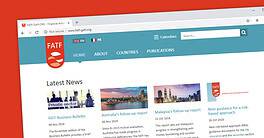COVER STORY: GLOBAL BANKING REGULATIONS
The fight has just begun, as newly enacted Fed rules start to cramp long-accepted operating styles of global banks. The banks are weighing what to do about it—as are global policymakers.
Outside the United States, banks are wincing, as the prudential standards adopted under Section 165 of the Dodd-Frank legislation begin at last to bite. The US Congress passed that reform in the wake of the financial crisis, to guard against future financial system meltdowns and to shield US taxpayers from the risk of having to fund potential bailouts. But the reforms extend beyond banks based in the US: They place operational limits on banks all over the globe that operate there. As regulators begin to implement the statute’s broad requirements, foreign institutions are starting to feel the pain.
This may be just the first battle, moreover, in a larger war between global policymakers. Although the final rules are milder than some global market participants expected, there are still some clear consequences—and some more-opaque potential effects—for the entire global banking industry. It could lead to retaliation from global regulators against US banks operating in their markets. It could also lead to higher costs for corporates, as financial institutions pass the cost of compliance on to their clients.
Regardless, it opens a Pandora’s box of potential outcomes for global banks and most certainly will affect more than just foreign banks with large US operations.
UNDER THE MICROSCOPE
The final rules adopted under Section 165 divide foreign banks into three tiers, based on asset size. Smaller firms with consolidated assets ranging from $10 billion to $50 billion must now undergo capital stress testing and establish a risk committee, if publicly traded. Midsize organizations—with total consolidated assets greater than $50 billion but US assets less than $50 billion—must additionally comply with risk-based and leverage capital levels, as well as liquidity risk management requirements. Large firms—with over $50 billion in US assets—will need to set up a holding company to ring-fence those assets—including separately chartered banks and broker-dealer operations.
Dodd-Frank beefed up the oversight of activities of foreign institutions that might potentially endanger the US financial system. “Consider the regulatory climate in the United States: the strong desire to eliminate the so-called too-big-to-fail banks, while maintaining a level playing field and protecting the US economy,” notes Oliver Ireland, partner in the financial services practice at Morrison Foerster. The responsibility fell to the US Federal Reserve to interpret the statute’s mandate, which the central bank has done in several steps, with a final rule issued February 18, 2014. Now firms have until July 1, 2016, to comply and until 2018 to meet leverage ratios.
The Fed could actually have done much more, such as force all US assets under the umbrella structures. Instead, however, it left out branching functions. “They could also have applied the US rule to foreign banks in foreign jurisdictions, regulating home country operations,” says Ireland.
American regulators justify these prudential measures by referencing the Federal Reserve’s role in 2008. The central bank then allowed foreign banks to access its “discount window” for short-term loans to keep credit flowing and prevent cash shortfalls. Harvey Pitt, former Securities and Exchange chairman and current chief executive officer at Kalorama Partners, disagrees with that rationale and rejects the characterization as a bailout during the crisis. He points out that “no actual capital was given. The Fed can always decide whom it will allow to use the discount window and under what circumstances.”
WHO WILL BEAR THE COSTS?
European banks and a few Asian ones will be caught in the crosshairs. The new rule imposes direct outlays, such as the expense of preparing stress tests and risk management procedures, and more onerous reporting, while higher capital levels represent opportunity costs for trapped funds. Borrowing costs will go up, as firms move to comply with higher leverage ratios. When the largest banks establish new holding structures, those umbrellas will become subject to new capital ratios.
Ultimately, shareholders and clients of the banks will bear the brunt, warns Brian Harte of London-based consultancy Berkeley Research Group. “Returns may fall temporarily,” he says, “but that process can’t go on forever. Pressure from disgruntled investors will demand a certain rate of return.” He notes that investors at Barclays and HSBC have already voted with their feet, pummeling those banks’ stock prices.
Each firm must address its own operations: How are they structured today, and how will the new regime change that? If they already have a US holding vehicle, the rules may not ratchet up costs much. If they must move assets, what must move? Liquidity also plays a part, since banks need to maintain adequate reserves to create a margin of safety for the withdrawal of funds or maturing deposits. The runoff from wholesale funding may vary, depending on how organizations finance themselves. Under the Basel III framework, assumptions for retail runoffs are lower than for wholesale. Thus, those institutions that rely on wholesale funding for their dollar needs would be more affected; retail lenders like HSBC and Santander, who use more deposit funding, would be less exposed.
The final rule relaxed some proposed conditions, like increasing the threshold for the holding company requirement to over $50 billion for US nonbranch assets. “Some of the retail banks have already adopted a subsidiary structure comparable to what is requested, but others have not,” notes Sébastien de Brouwer, executive director at the European Banking Federation. The Fed has estimated that about 15 to 20 of the largest banks will be subject to the holding company provision.
Despite the grumbling, there is some case to be made for what James Phillips terms a “fitness boost.” Phillips, regulatory strategy director at Lombard Risk, notes: “Regulation means paying the rent. If you don’t want to be regulated, you can’t play.” He explains that enforcing more robust levels of systems control, internal risk management, improved management of information and higher standards across the board may actually produce a positive result for the firm.
MARKET RESPONSE
Foreign entities have already begun to reorder their operations and balance sheets. Strategies range from contracting assets below the Fed’s thresholds to exiting US businesses. “Some will reallocate assets to other hubs, to Europe and Asia—for instance, assets that belong to Latin American clients,” suggests de Brouwer. Two banks have already announced they will reduce their US balance sheets: Deutsche Bank is trimming between $300 and $400 billion, and Royal Bank of Scotland aims to slim down below the $50 billion level. Some players may reduce their wholesale assets, and others may winnow their repo businesses. “The margin for repo is quite low, and that activity is often used as a gateway for other types of services,” de Brouwer explains.Institutions will make individual decisions about their competitive positioning in the United States and whether the disruption is worth it. For instance, says Ireland, “they might look at their broker-dealer business and conclude it isn’t as lucrative as hoped for, or they might decide to keep it but narrow the activities.” Longer-term, if the plan is for growth in the US market, it would be counterproductive to downsize to get below the
$50 billion threshold, because at some point the assets will climb back again across that level.
Pitt laments the consequences of any exodus from the United States: “We should want to attract as many foreign assets as possible. It takes confidence on the part of foreign entities to keep their assets in a foreign jurisdiction. Losing billions of dollars in assets that would otherwise be resident in the United States will do more to undermine financial stability in the next crisis than any protection these rules will provide.” In a further ironic twist, the US Internal Revenue Service has been vigorously fighting the deployment of assets overseas, as it tries to subject them to US taxation.
Non-US banks appear to have their hands tied. “To an extent, this is a done deal. Now they just have to comply,” de Brouwer acknowledges. Until the final ruling, there were many long discussions between the banking industry, foreign authorities and the European Commission, hoping a more liberal approach might prevail.
UK LOOKS AT SUBSIDIARY BANK STRUCTURES:
UK regulators have been discussing their own equivalent of the Fed rules, to determine whether non-UK banks should be forced to subsidiarize. The discussion, at an early stage, is being consulted on by the Prudential Regulation Authority, itself a subsidiary of the Bank of England. The PRA is focusing on three factors: Is a given branch operating under an equivalent home-state supervisory regime? Does the branch perform a critical economic function? Are appropriate resolution arrangements in place for that branch? “It’s another example of extraterritoriality, where the regulator on the host patch is reaching beyond the diplomatic barrier and interacting with the DNA of the home country,” says James Phillips, regulatory strategy director at Lombard Risk. Under this proposed regulation, the PRA is principally concerned about regulating risks to depositors, i.e., the products available to ordinary retail customers, rather than broker-dealer or investment functions. “In the US,” says Phillips, “some foreign bank operations have grown substantial broker-dealer operations. That gives rise to different risks.
RETALIATION?
Now that those hopes are dashed, could some form of retaliation be in the offing? On April 18, 2013, European Commissioner Michel Barnier wrote to then-Fed-chief Ben Bernanke that the proposals “could spark a protectionist reaction from other jurisdictions, which could ultimately have a substantial negative impact on the global economic recovery.” Pitt warns that now there will be “pressures on foreign regulators to respond, all of which could and should have been avoided by a more diplomatic approach—throwing down the gauntlet was not the right way for US regulators to behave.”
But US banks are already more heavily regulated than European counterparts, which would make it harder for European banks to raise an equivalent bar. Alan Blinder, former vice chairman of the Federal Reserve, pondered the question. It is possible, he speculated, that “we could get into a tit for tat” involving other industries, recalling the divergent transatlantic regulation of genetically modified foods during the 1990s.
By insisting on super holding companies within Europe, the EU could indeed mirror the US position. In 2004 the SEC came up with its voluntary Consolidated Supervised Entities (holding companies) program, designed to meet European requirements that some US broker-dealers must be subject de novo to regulation by European authorities. (The CSE program was in fact terminated in 2008, since two of the major investment firms had closed and three had changed their regulator.)
Non-US regulators might take a more oblique path, such as adjusting the current reciprocal passporting arrangements. In the late 1980s, the EU’s second banking directive created the principle of mutual recognition, so that each EU member state would be able recognize the competence of the banking regulators in all of the other member states. For instance, an Italian bank could open a London branch in a fast-track process. Even “third countries” like the United States, Japan and Switzerland benefited from reciprocity: If EU regulators felt the US banking regulatory authorities were equal to European competent authorities, they could then branch within the EU through an EU-incorporated banking subsidiary. Harte suggests that, now the reciprocal arrangement has been impaired, the EU might “restrict or even stop allowing the US entities to take advantage of that directive.”
Judicial review offers another possible route of retaliation for foreign institutions or organizations. “When rules adopted under Dodd-Frank have been challenged in US courts, regulators have fared very poorly,” Pitt notes. “In the local court of appeals in Washington DC, the SEC hasn’t won a rulemaking challenge since 1996.”
It is understandable from the US point of view to protect the home banking system. Yet if other authorities follow suit on a cross-border basis, it risks fragmenting groups into local supervision again. Harte takes up that theme of globalization, and the
tension between those who want to promote and those who want to impair it, describing the Fed’s rules as “a classic retreat toward a nation state.” Pitt meanwhile suggests that an underlying motive for the Fed’s action might also be to provide the Treasury with some “deniability.” Although the administration would undoubtedly have been complicit, at least Treasury could deflect some blame when global finance ministers meet.
De Brouwer is adamant, however, that Barnier never clearly mentioned “retaliation,” which would be a huge step backward for international banking markets if all participants were to act in similar fashion. “It’s more a matter of disappointment from the EU side,” he says, “although it does set a negative precedent and may adversely impact global cooperation.” For example, How will it affect attempts of the Basel Committee and the G20 to coordinate global bank supervision and cross-border resolution? De Brouwer promises, “We’ll continue to press for more coherence and better coordination in coming years and assess whether rules adopted in one part of the market can provide an applicable cross-border framework.”



